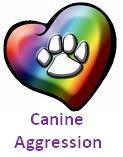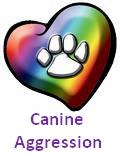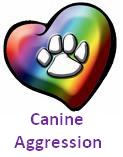
Petfinder recommends that you should always take reasonable security steps before making online payments.
Meet Canine Aggression
TREATMENT OF CANINE DOMINANCE-RELATED AGGRESSION
Dogs are a pack-living species and within that pack one dog is the top or “alpha” dog who has first choice of food, mate and resting place. Few dogs challenge the dominant or alpha dog but those that do will be threatened with a growl or snap or are punished with a bite. Pet dogs consider their owners members of the “pack” and in this pack there is a hierarchy. Most pet dogs naturally accept their role at the bottom, but dominant-aggressive dogs prefer to be near the top. If challenged, the dog may respond with a growl, snap or bite. While each individual is unique, dominant dogs are challenged and may act aggressive in the following circumstances:
1. When protecting food (dog food or human food), garbage, and certain objects (toys, stolen objects).
2. If disturbed while sleeping or resting, especially in socially significant areas such as furniture.
3. When a certain, closely bonded family member is approached or touched by other family members.
4. When the feel certain actions “threaten” this status. This can include certain postures such as bending over the dog, prolonged staring, punishment, pulling by the leash or collar, or even petting.
The dog may exhibit this behavior toward all family members or only to specific
people. This behavior may emerge in puppyhood, but dogs usually begin to exhibit serious aggression near the age of social maturity (1-3 years). Because this is usually an inherited behavior (with components of learned behavior), it cannot be completely “cured”. Aggression can often, however, be controlled so that the dog remains a good pet. Treatment must therefore continue for the life of the dog. Treatment involves a combination of prevention of injury and behavior modification to change the dominant attitude of the dog, as follows. Consider every interaction you have with the dog. Be sure that you, not the dog, are making the decisions, i.e. you are the leader.
∆ To make the dog more dependent upon you, and less independent, remove all gratuitous attention. The dog should no longer receive “free petting” from the family.
a. For ________________, all attention should be withdrawn completely except for obedience training, feeding, and exercise. Exercise should be increased and it should be on lead only.
b. For the following ______________, you can begin to pay attention to the dog but it must be your idea, not the dog’s, and he/she should obey a SIT or DOWN first. Continue to ignore the dog when he/she solicits attention.
c. Finally, after this period, you can begin to pay attention even when the dog asks for it but he/she must obey and obedience command first, and it is important to still ignore the dog at least 50% of the time. If the dog relapses, return to no petting.
∆ Practice obedience training following the Sit-Stay handout given to you. Work on the STAY command, at your dog’s pace. Work through the handout once giving a treat for every successful command, then repeat it giving a reward every other time, and finally you should be able to go through it rewarding your dog randomly.
∆ If a Promise collar was dispensed, use it as recommended. With or without a Promise collar, the dog should have a lead on at all times, indoors as well as outdoors.
∆ Purchase a basket-type muzzle for times when there is some risk the dog may bite. A comfortable muzzle is p referable to isolating the dog.
∆ Always actively surprise the dog around babies, toddlers and small children. Elderly people may also need to be accompanied.
∆ Avoid eliciting aggression. You know what situations lead to aggression. Avoid physical punishment – it can incite aggression. Instead, use a loud noise such as a handclap or a foghorn. You may also use the Promise collar if it has been dispensed (not advised for cases of severe aggression). It is best to avoid eliciting aggression.
∆ Practice an enforced down. This helps to reinforce your dominance. Use food, if necessary, to persuade the dog to lie down or give a down command. Then hold the dog down by placin your foot on the leash close to the collar. Wear sturdy shoes. Keep him/her down for 30 minutes. You may have to work up to this gradually starting with 5 minutes.
∆ Avoid injury – if your dog threatens you in any way, do not confront him/her. Instead, look away and walk away, then figure out how to avoid the circumstance next time. If possible, redirect the mood: “Do you want to go out?” “Want to play fetch?”
∆ Do not allow your dog on furniture, especially the bed or any other piece of furniture used by people. If you feel he/she will “sneak” on when you are not home, you have three choices:
(a) shut the door and keep the dog out of the room; (b) “booby trap” the furniture in order to correct the behavior even in your absence; (c) allow the dog on certain pieces but be sure he/she never is allowed on when there is a human on the furniture. Let the dog know you know, i.e. command him/her on and off randomly.
∆ Pick up the dog’s toys so they are unavailable, and begin to allocate them when you want him/her to have a toy. This will make the dog less independent and it will provide a “pacifier” for times when you want to dog to be occupied.
∆ Change your dog’s diet to one with lower protein, preferable 6 per day). Take him/her out on a leash, don’t tie him/her outside. Make him/her sit, precede him out the door, then let him come out.
∆ If your dog obtains an item you do not want him/her to have, trade with a piece of good food. Show the dog the food, tell him/her to drop and come to you, away from the item, then thell the dog to SIT and reward with the food.
This program should be continued indefinitely. Many dogs do improve once they realize they cannot have their way as before, and this way they have been trained safely. Remember that dominant-aggressive dogs usually do not respond to forceful training; in fact, such training is likely to result in a bite. Monitor your dog’s behavior changes over time and keep a journal of incidents of growling, snapping or biting. Good Luck!
Animal Behavior Clinic
College of Veterinary Medicine
Cornell University
Ithaca, NY 14853
(607) 23-3450
Dogs are a pack-living species and within that pack one dog is the top or “alpha” dog who has first choice of food, mate and resting place. Few dogs challenge the dominant or alpha dog but those that do will be threatened with a growl or snap or are punished with a bite. Pet dogs consider their owners members of the “pack” and in this pack there is a hierarchy. Most pet dogs naturally accept their role at the bottom, but dominant-aggressive dogs prefer to be near the top. If challenged, the dog may respond with a growl, snap or bite. While each individual is unique, dominant dogs are challenged and may act aggressive in the following circumstances:
1. When protecting food (dog food or human food), garbage, and certain objects (toys, stolen objects).
2. If disturbed while sleeping or resting, especially in socially significant areas such as furniture.
3. When a certain, closely bonded family member is approached or touched by other family members.
4. When the feel certain actions “threaten” this status. This can include certain postures such as bending over the dog, prolonged staring, punishment, pulling by the leash or collar, or even petting.
The dog may exhibit this behavior toward all family members or only to specific
people. This behavior may emerge in puppyhood, but dogs usually begin to exhibit serious aggression near the age of social maturity (1-3 years). Because this is usually an inherited behavior (with components of learned behavior), it cannot be completely “cured”. Aggression can often, however, be controlled so that the dog remains a good pet. Treatment must therefore continue for the life of the dog. Treatment involves a combination of prevention of injury and behavior modification to change the dominant attitude of the dog, as follows. Consider every interaction you have with the dog. Be sure that you, not the dog, are making the decisions, i.e. you are the leader.
∆ To make the dog more dependent upon you, and less independent, remove all gratuitous attention. The dog should no longer receive “free petting” from the family.
a. For ________________, all attention should be withdrawn completely except for obedience training, feeding, and exercise. Exercise should be increased and it should be on lead only.
b. For the following ______________, you can begin to pay attention to the dog but it must be your idea, not the dog’s, and he/she should obey a SIT or DOWN first. Continue to ignore the dog when he/she solicits attention.
c. Finally, after this period, you can begin to pay attention even when the dog asks for it but he/she must obey and obedience command first, and it is important to still ignore the dog at least 50% of the time. If the dog relapses, return to no petting.
∆ Practice obedience training following the Sit-Stay handout given to you. Work on the STAY command, at your dog’s pace. Work through the handout once giving a treat for every successful command, then repeat it giving a reward every other time, and finally you should be able to go through it rewarding your dog randomly.
∆ If a Promise collar was dispensed, use it as recommended. With or without a Promise collar, the dog should have a lead on at all times, indoors as well as outdoors.
∆ Purchase a basket-type muzzle for times when there is some risk the dog may bite. A comfortable muzzle is p referable to isolating the dog.
∆ Always actively surprise the dog around babies, toddlers and small children. Elderly people may also need to be accompanied.
∆ Avoid eliciting aggression. You know what situations lead to aggression. Avoid physical punishment – it can incite aggression. Instead, use a loud noise such as a handclap or a foghorn. You may also use the Promise collar if it has been dispensed (not advised for cases of severe aggression). It is best to avoid eliciting aggression.
∆ Practice an enforced down. This helps to reinforce your dominance. Use food, if necessary, to persuade the dog to lie down or give a down command. Then hold the dog down by placin your foot on the leash close to the collar. Wear sturdy shoes. Keep him/her down for 30 minutes. You may have to work up to this gradually starting with 5 minutes.
∆ Avoid injury – if your dog threatens you in any way, do not confront him/her. Instead, look away and walk away, then figure out how to avoid the circumstance next time. If possible, redirect the mood: “Do you want to go out?” “Want to play fetch?”
∆ Do not allow your dog on furniture, especially the bed or any other piece of furniture used by people. If you feel he/she will “sneak” on when you are not home, you have three choices:
(a) shut the door and keep the dog out of the room; (b) “booby trap” the furniture in order to correct the behavior even in your absence; (c) allow the dog on certain pieces but be sure he/she never is allowed on when there is a human on the furniture. Let the dog know you know, i.e. command him/her on and off randomly.
∆ Pick up the dog’s toys so they are unavailable, and begin to allocate them when you want him/her to have a toy. This will make the dog less independent and it will provide a “pacifier” for times when you want to dog to be occupied.
∆ Change your dog’s diet to one with lower protein, preferable 6 per day). Take him/her out on a leash, don’t tie him/her outside. Make him/her sit, precede him out the door, then let him come out.
∆ If your dog obtains an item you do not want him/her to have, trade with a piece of good food. Show the dog the food, tell him/her to drop and come to you, away from the item, then thell the dog to SIT and reward with the food.
This program should be continued indefinitely. Many dogs do improve once they realize they cannot have their way as before, and this way they have been trained safely. Remember that dominant-aggressive dogs usually do not respond to forceful training; in fact, such training is likely to result in a bite. Monitor your dog’s behavior changes over time and keep a journal of incidents of growling, snapping or biting. Good Luck!
Animal Behavior Clinic
College of Veterinary Medicine
Cornell University
Ithaca, NY 14853
(607) 23-3450
Recommended Content
Recommended Pets
Finding pets for you…
Recommended Pets
Finding pets for you…

Canine Aggression
- Affenpinscher
- Puppy
- Unknown
